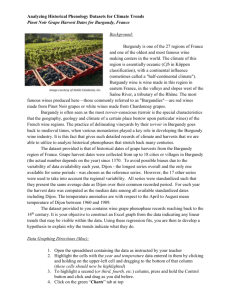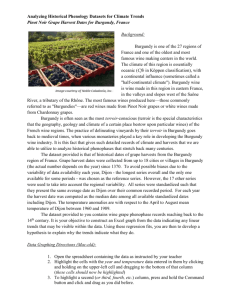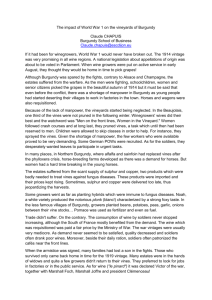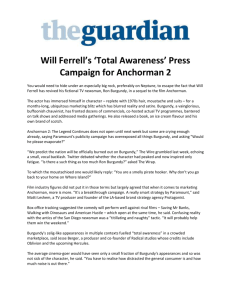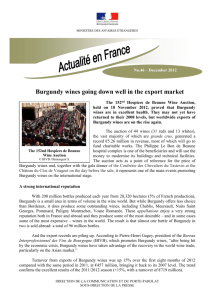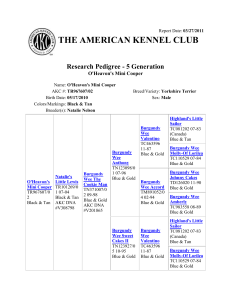Client Disclosure Statement
advertisement
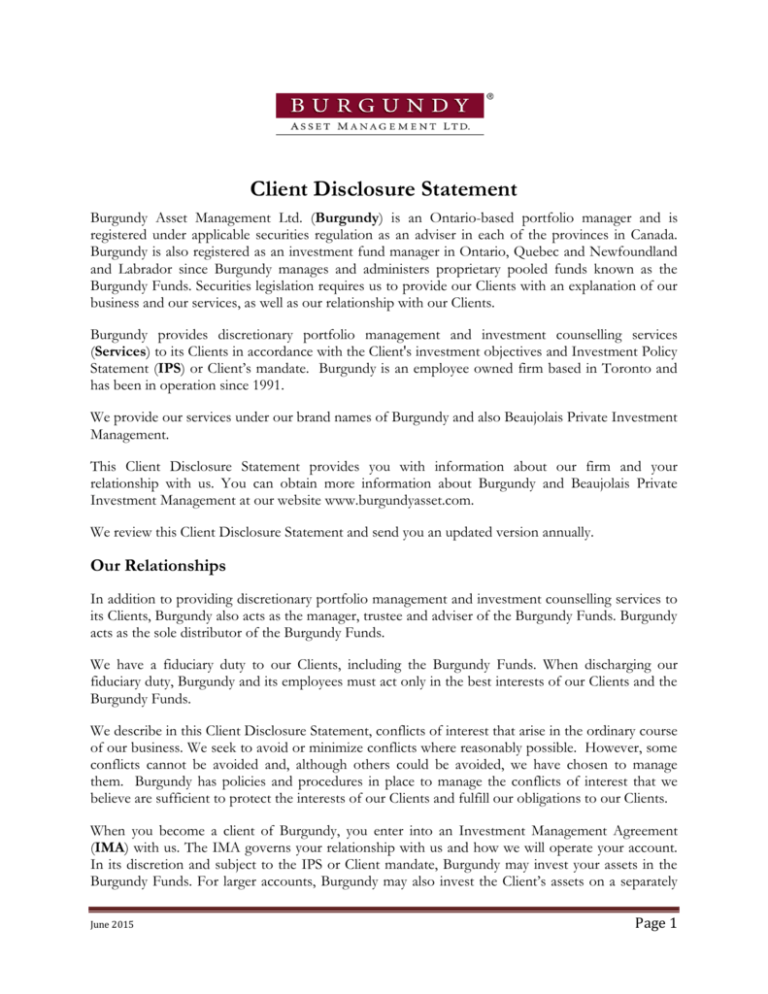
Client Disclosure Statement Burgundy Asset Management Ltd. (Burgundy) is an Ontario-based portfolio manager and is registered under applicable securities regulation as an adviser in each of the provinces in Canada. Burgundy is also registered as an investment fund manager in Ontario, Quebec and Newfoundland and Labrador since Burgundy manages and administers proprietary pooled funds known as the Burgundy Funds. Securities legislation requires us to provide our Clients with an explanation of our business and our services, as well as our relationship with our Clients. Burgundy provides discretionary portfolio management and investment counselling services (Services) to its Clients in accordance with the Client's investment objectives and Investment Policy Statement (IPS) or Client’s mandate. Burgundy is an employee owned firm based in Toronto and has been in operation since 1991. We provide our services under our brand names of Burgundy and also Beaujolais Private Investment Management. This Client Disclosure Statement provides you with information about our firm and your relationship with us. You can obtain more information about Burgundy and Beaujolais Private Investment Management at our website www.burgundyasset.com. We review this Client Disclosure Statement and send you an updated version annually. Our Relationships In addition to providing discretionary portfolio management and investment counselling services to its Clients, Burgundy also acts as the manager, trustee and adviser of the Burgundy Funds. Burgundy acts as the sole distributor of the Burgundy Funds. We have a fiduciary duty to our Clients, including the Burgundy Funds. When discharging our fiduciary duty, Burgundy and its employees must act only in the best interests of our Clients and the Burgundy Funds. We describe in this Client Disclosure Statement, conflicts of interest that arise in the ordinary course of our business. We seek to avoid or minimize conflicts where reasonably possible. However, some conflicts cannot be avoided and, although others could be avoided, we have chosen to manage them. Burgundy has policies and procedures in place to manage the conflicts of interest that we believe are sufficient to protect the interests of our Clients and fulfill our obligations to our Clients. When you become a client of Burgundy, you enter into an Investment Management Agreement (IMA) with us. The IMA governs your relationship with us and how we will operate your account. In its discretion and subject to the IPS or Client mandate, Burgundy may invest your assets in the Burgundy Funds. For larger accounts, Burgundy may also invest the Client’s assets on a separately June 2015 Page 1 managed basis. Each Client’s account will be referred to in this Client Disclosure Statement as a Client Portfolio. In trading under discretionary authority or advising with respect to investments in its Clients’ Portfolios, Burgundy will act in accordance with each Client’s Investment Policy Statement (IPS) or Client’s mandate. In all investment decisions, Burgundy will deal fairly, honestly and in good faith with its Clients. Information required to comply with “know-your-client” obligations Burgundy is generally required by Canadian securities laws to take reasonable steps to establish each Client’s identity and ensure that Burgundy has sufficient information regarding each Client’s investment needs and objectives, financial circumstances and level of risk tolerance, to enable Burgundy to meet its obligation under applicable securities laws to ensure that the purchases and sales of securities that Burgundy makes on behalf of each Client are suitable for the Client. In addition, in certain circumstances, Burgundy may also be required to make enquiries as to a Client’s reputation. Anti-money laundering laws also require Burgundy to take reasonable steps to determine whether a Client is a “politically exposed foreign person” within the meaning of those laws. In order to comply with these requirements, Burgundy will obtain the following information from each Client when the Client first opens an account with Burgundy. The nature and extent of the information required will depend on the Client: For individuals: June 2015 full legal name, home address, and other contact information (and for any beneficiary of the Client’s account). date of birth, social insurance number, residency and U.S. status. information regarding family circumstances and family, including information regarding the Client’s spouse, children and other dependants. information regarding the Client’s financial circumstances, including net worth and employment and other income. information about the Client’s employment. previous experience with investments, and current investment needs and objectives. level of risk tolerance with respect to the Client Portfolio. confirmation as to whether the Client is a director or other “insider” of a publicly traded company. to assist Burgundy with verifying the Client’s identity: o A copy of valid photo identification, such as a driver’s license or passport; o Authorization to perform an ID Product check or Attestation; and o A personal cheque in the amount of $1.00. confirmation as to whether the Client is a “politically exposed foreign person” within the meaning of anti-money laundering laws. U.S. Initial Public Offering (IPO) eligibility status Page 2 For corporations, trusts or partnerships: information regarding financial circumstances. information regarding the nature of the Client’s business. previous experience with investments, and current investment needs and objectives. level of risk tolerance with respect to the Client Portfolio. confirmation as to whether the Client is an “insider” of a publicly traded company. for corporations, the name and occupation of all directors, and the name, address, date of birth, occupation, and U.S. person status of all shareholders who directly or indirectly own or control 25% or more of the shares of the corporation. for partnerships or trusts, the name of each individual who exercises control over the affairs of the partnership or trust, and the name, address, date of birth, occupation, and U.S. person status of all individuals who directly or indirectly own or control 25% or more of the entity. a copy of a certificate of corporate status, partnership agreement, articles of association, declaration of trust or similar document. a copy of a record of the corporation, partnership or trust identifying the individuals who are authorized to provide instructions to Burgundy, and with respect to each such individual: o A copy of valid photo identification, such as a driver’s license or passport; o Authorization to perform an ID Product check or Attestation; o A personal cheque in the amount of $1.00. U.S. Initial Public Offering (IPO) eligibility status Burgundy will request this information at the time of account opening. It will be important for the Client to keep Burgundy informed of any changes throughout the relationship. If the Client is an insider of a reporting issuer or other public entity, the Client must notify Burgundy of any restrictions on investing Client Portfolios in that entity. Dealings with Related or Connected Issuers Burgundy does not itself issue securities or other assets that would be included in a Client Portfolio. As an adviser, Burgundy may invest in or advise as to investment in securities, which may include securities of a related or connected issuer. A related issuer is a person or company that influences or is influenced by another person or company. A connected issuer is an issuer of securities that has a relationship with Burgundy that, in connection with the distribution of securities of the issuer, is material to a prospective purchaser of the securities. If such a relationship existed, the relationship may be material if it is likely that a reasonable prospective purchaser would consider it important under the circumstances to their decision to purchase. Burgundy has a relationship with the Burgundy Funds due to Burgundy’s role as manager, trustee and portfolio adviser of the Burgundy Funds. A related registrant is a registered adviser or dealer under securities legislation that has a principal shareholder, director or officer that is a principal shareholder, director or officer of Burgundy. Burgundy does not have any related registrants. If Burgundy's relationships change to add related or connected issuers other than the Burgundy Funds, it will inform the Client of the relationship before performing any of the Services; and, where June 2015 Page 3 applicable, it will obtain the Client’s specific and informed written consent to such investment direction prior to exercising discretion with respect to investments in those issuers. Clients of Burgundy may be entities that issue securities (public companies) or may be related to such an entity (for example a pension plan of a public company) (Issuer Clients). From time to time, Burgundy may cause Client Portfolios and the Burgundy Funds to invest in securities of an Issuer Client. Burgundy will only make such an investment decision when it considers that the investment is in the best interests of the Client Portfolio or the Burgundy Fund(s) and will make the decision independently from considerations related to the fact that the issuer of the securities is an Issuer Client. Under applicable securities laws, there may be certain restrictions on trading activities in the securities of Issuer Clients because of Burgundy’s relationship with the Issuer Client, depending on the level of knowledge that Burgundy has about the Issuer Client. If the Client is an insider of a reporting issuer or other publicly traded entity, the Client must notify Burgundy if the Client wishes their Client Portfolio to be restricted from investing in securities of the applicable entity. The fact that a Client is an insider of an entity does not restrict Burgundy from investing in securities of that entity for other Clients or the Burgundy Funds. It is the Client’s responsibility to submit the required regulatory filings as it pertains to their insider status. Allocation of Investment Opportunities Burgundy expressly recognizes the absolute need for fairness in the allocation of investment opportunities among the Burgundy Funds and/or other investment accounts that Burgundy manages or may manage in the future. In addition, the directors, officers and employees of Burgundy are subject to a personal trading policy, which governs their personal investment activities, and is compliant with legislation and with industry and CFA Institute standards. Burgundy’s policies are that any director, officer and employee shall: June 2015 1. ensure that he or she deals fairly in the allocation of investment opportunities among all eligible Clients; 2. always have a reasonable and adequate basis for investment recommendations made to Clients supported by appropriate research and investigation; 3. exercise diligence, thoroughness and independent professional judgment in making any recommendations to Clients and in taking investment action for them; 4. in the event of limited availability of any particular security, such as an initial public offering, or in the event of a limited market for any particular security, allocate the opportunity to all eligible accounts on an equitable pro rata basis having regard to such factors as Burgundy considers relevant in the circumstances; 5. ensure that any trades done on a bulk basis or in respect of an initial public offering are allocated amongst Clients accounts fairly and equitably; and 6. seek best execution with respect to brokerage transactions, taking into consideration both the ease and timeliness of the trade and the cost of such execution. Page 4 Cross Trading Securities and In Specie Transactions Under Canadian securities laws, Burgundy is subject to certain prohibitions against cross trading securities between a Client account and a Burgundy Fund, or between two Burgundy Funds. In addition, Burgundy is prohibited from purchasing or redeeming units of the Burgundy Funds “in kind” (i.e. the transfer of securities from a Client’s account to purchase units of a Burgundy Fund, or the transfer of securities from a Burgundy Fund to the Client’s account to redeem the Client’s investment in the Burgundy Fund). Burgundy has obtained an exemption from the securities regulators to permit it to engage in cross trading and in specie transactions. Burgundy will only do so for a Client Portfolio if it has obtained the prior written consent of the Client to engage in such activities and where the security being transferred will meet the investment criteria of the Client Portfolio or Burgundy Fund that receives the security. In addition, Burgundy will only engage in cross trades involving a Burgundy Fund where it has obtained the approval of the Burgundy Funds’ Independent Fund Governance Committee and complies with the terms of any standing instructions from the Independent Fund Governance Committee regarding the transaction. Use of Client Brokerage Commissions (Soft Dollars) Burgundy does not use brokerage commissions for the payment of portfolio management systems, trading systems or databases of any kind. The decision to cease using commissions for these purposes was implemented in February 2004, when we also discontinued accepting client-directed brokerage arrangements. We believe this ultimately results in more efficient trading and lower commission costs for all our Clients. In some cases, Burgundy may allocate commissions to selected brokers in order to obtain specialized independent third-party research. Typically, the amount of commissions paid for this research is immaterial. This specialized research forms part of the investment decision-making process and, as such, is of benefit to our Clients. Many of the brokerage firms that Burgundy uses provide “bundled” trading fees that cannot necessarily be separated into research and execution. Although Burgundy may quite often disregard the research information provided by these brokers, we may pursue trades with them in order to access the necessary liquidity or trading expertise required for Burgundy to trade a position in the most efficient manner. In addition, these brokers may also provide access to company managements which is an integral part of our research process. Burgundy is obligated to seek best execution for its Clients. The price of the trade and the commission paid are not the only indicators of “best execution”. Other items which may be considered in judging “best execution” include: June 2015 Avoiding excessive market impact when trading; Maintaining the confidentiality of investment decisions; Choosing appropriate brokers, taking into account a broker’s abilities, including: o access to liquidity; o the speed and accuracy of transaction execution; o price/commissions charged; and o access to research conferences and company managements. Page 5 Burgundy makes a good faith determination that all Clients receive reasonable benefit from the use of order execution and research goods and services received, relative to the amount of brokerage commission paid. Burgundy makes this determination relative to its overall responsibilities for all Client accounts. Burgundy has always been very conservative in regards to the use of client brokerage commissions and/or “soft dollars” and has always adhered to the standards set out by the CFA Institute, which calls for full disclosure and high ethical practices by investment managers in their capacity as a fiduciary for their clients. On an annual basis, Burgundy will send its Clients a notice describing the types of goods or services, other than order execution, provided in exchange for brokerage commissions during the past year. Upon request, Burgundy will provide a Client with the name of any dealer or third party that provided research goods or services to Burgundy during the past year. Performance Fees and Side-By-Side Management Burgundy may enter into a performance fee arrangement with some of its Clients. Side-by-side management refers to the simultaneous management of multiple types of Client accounts. A conflict of interest may exist when an employee is responsible for accounts that are charged a performance fee and other accounts that are charged a base asset management fee. Burgundy may have a financial incentive to favour accounts with performance fees and an incentive to allocate trades in favour of such accounts. Burgundy and its employees are cognizant of their responsibility to always act in the best interests of all our Clients. We have created a series of policies and procedures addressing the potential conflict areas. More specifically, to ensure fairness in the allocation of investment opportunities amongst all eligible Clients, we follow our Allocation of Investment Opportunities Policy in order to address this potential conflict. Burgundy’s Compliance department, under the leadership of the Chief Compliance Officer, administers a comprehensive set of policies and procedures designed to address a variety of conflicts that may arise from managing multiple accounts on a side-by-side basis, including, without limitation, conflicts that may arise from the purchase or sale of the same securities for more than one Client and transactions between Clients. The Compliance department is responsible for formalizing these and other policies and procedures, providing firm-wide training as it relates to compliance issues, carrying out annual reviews, identifying and reporting conflicts of interest, and lastly, fostering a culture of compliance at Burgundy. Personal Trading Burgundy has implemented a comprehensive personal trading policy to eliminate the conflicts of interest that could arise if employees were permitted to trade in their own accounts (or those over which they have influence) the same securities which are held by Burgundy for its Clients, including those held by the Burgundy Funds. To ensure that Burgundy upholds its fiduciary responsibilities to its Clients, no employee is allowed to trade until all Client trades are completed. Every employee of Burgundy is considered an access person, and as such, must obtain prior written approval from the Chief Compliance Officer or in his/her absence, the Chief Financial Officer for any security trade they would like to execute in any June 2015 Page 6 personal account, or an account where they are deemed to have a beneficial interest. Appropriate blackout periods are invoked as a standard practice. In addition, for any security in which Burgundy may have an interest, or is following closely, a blackout period may also be invoked, at the discretion of the Chief Compliance Officer. Any employee with an external personal trading account must submit to the Chief Compliance Officer a copy of his or her monthly brokerage statements for all accounts where the employee is deemed to have beneficial interest. In addition, trading compliance is verified against a monthly trading disclosure statement, which all employees must sign, whether they traded or not. Gifts & Entertainment The acceptance of gifts can be perceived as a conflict of interest; as such Burgundy has established a comprehensive policy that limits the acceptance of gifts and entertainment consistent with the CFA Institute guidelines. Burgundy does not allow its employees to accept nor solicit gifts or entertainment that are reasonably expected to compromise the employee’s independence or objectivity. Directorships and Outside Employment Burgundy has adopted the guidelines outlined in the CFA Institute’s Standards of Professional Conduct regarding the appointment of employees on the board of directors and/or committees of external organizations. As such, employees may serve on the board of directors or other committees of organizations/corporations so long as the employee obtains prior approval from Burgundy’s CEO, to ensure this activity would not interfere or give the appearance of interfering with an employee’s ability to act in the best interest of Burgundy and its Clients. Employees cannot hold a position on a board when Burgundy manages the assets for that specific entity and their board position involves making investment decisions for that entity. If any Burgundy employee serves as a director of a publicly traded company, Burgundy cannot invest in securities of that issuer, therefore, Burgundy generally restricts this activity for its employees. Referral Arrangements Burgundy does not enter into referral arrangements in respect of its Clients. If Burgundy does enter into a referral arrangement in the future, it will, prior to entering into such arrangement in respect of a Client, provide the Client with written disclosure regarding the arrangement, including the name of each party, the purpose and material terms of the arrangement and the method of calculating the referral fee. Fees The Client agrees to pay Burgundy an investment management fee (Fee) as set out in the IMA. The Fee may also include a performance fee if the Client is invested in certain specialty mandates as set out in the IMA. Burgundy will give the Client at least 60 days’ notice of any increase in the Fee. Management fees are not charged to the Burgundy Funds directly. Burgundy does not charge or receive any sales commissions for purchases of Burgundy Funds. In certain limited circumstances, we may cause a Burgundy Fund to charge a fee to a Client that is purchasing or redeeming units of the Burgundy Fund if we determine that the size of the purchase or redemption will have an impact on the Burgundy Fund or other investors in the Burgundy Fund. June 2015 Page 7 Expenses If Burgundy invests the Client Portfolio in a Burgundy Fund then the Client will bear a proportionate share of the operating expenses paid by that fund as outlined in the Declaration of Trust, including: brokerage, custody and safekeeping charges, legal, audit, regulatory, trustee, recordkeeping, administrative and Independent Fund Governance Committee fees. Information about the operating expenses paid by the Burgundy Funds is included in their semi-annual financial statements, as well as their audited annual financial statements that are available upon request. If Burgundy invests the Client Portfolio on a separately managed basis then the Client will be responsible for the payment of all trading costs associated with such investments, including brokerage fees, commissions, expenses and custodial fees. Reports Within 30 days of the end of each calendar quarter, Burgundy provides the Client with an account statement which includes the following information about the Client Portfolio as at the end of the period: the name and quantity of each security in the account; the market value of each security in the account; the total market value of each security position in the account; any cash balance in the account; the total market value of all cash and securities in the account. This account statement will also include the following information for each transaction made for the Client during the period covered by the statement: the date of the transaction; the type of transaction; the name of the security; the number of securities; the price per security; the total value of the transaction. Redemptions/Purchases of the Burgundy Funds A unitholder may redeem all or part of his/her units from a Burgundy Fund by delivering to Burgundy, in proper order, a written (including fax or email) notice of the unitholder’s intention to redeem the investment. For the following funds, a notice period of at least 90 days prior to the intended redemption date is required: Burgundy Asian Equity Fund, Burgundy Canadian Small Cap Fund, Burgundy Emerging Markets Fund, Burgundy Emerging Markets Foundation Fund, Burgundy U.S. Smaller Companies Fund and Burgundy Total Return Bond Fund. This notice period may be waived by Burgundy, as trustee of the Burgundy Funds, in its sole discretion. For all other funds, the redemption notice must be received by Burgundy no later than 4:00 p.m. on the intended redemption date in order to receive the series net asset value per unit calculated on that valuation date. A completed redemption request received after that time, or on a day other than a June 2015 Page 8 valuation date for the Burgundy Fund, will receive the series net asset value per unit calculated on the next valuation date of the fund. As a result of a purchase or redemption of units of a Burgundy Fund, expenses may be incurred that materially impact the Burgundy Fund and other investors in the Burgundy Fund. Such expenses may include, but are not limited to, brokerage fees, custodian transaction charges and other direct expenses such as market impact cost. At Burgundy’s discretion, for large redemptions and purchases that may have an impact on a Burgundy Fund, Burgundy may deliver securities from the Burgundy Fund to the redeeming unitholder in payment of the redemption proceeds or may request that the unitholder deliver appropriate securities to the Burgundy Fund in payment of the purchase price. Any securities so delivered will or must be delivered in good order and will be valued, for a redemption, at a value that equals the amount at which those securities were valued in calculating the applicable net asset value of the Burgundy Fund, and for a purchase, at a value that equals the amount at which those securities would have been valued if they were assets of the Burgundy Fund. Alternatively, Burgundy may decide to charge the Client a fee, payable to the relevant Burgundy Fund, in an amount that approximates these costs. Common Risks of Investing Even though Burgundy has been authorized to make all investment decisions related to the management of the Client Portfolio, securities laws require Burgundy to provide the Client with a description of risks that should be considered when making an investment decision. This information is set out below. To the extent that the Client Portfolio is invested in Burgundy Funds, the Client Portfolio will bear the risks of the Burgundy Fund in proportion to its investment in the Burgundy Fund. Collectively, the Client Portfolio and the Burgundy Funds are referred to as the “Portfolio”. Before making any investment decision, it is important to consider investment goals, and level of risk tolerance, and the risks associated with the investment under consideration. Generally, there is a strong relationship between the amount of risk associated with a particular investment and its potential to increase in value in the long term. However, investment risks vary depending on the type of investment. General Investment Risks Depending on its investment objective, a Portfolio may own many securities of different types: equity securities, fixed-income securities and cash. The value of these securities varies from dayto-day, reflecting the market’s view of matters such as interest rates, economic conditions, market news and individual company developments. As a result, the value of the Portfolio will go up and down on a daily basis. The risks of investing in a particular security are related to the company’s capitalization, size, product lines, management skills, marketplaces and financial resources. Generally, equity and fixed-income securities of smaller or private companies are less liquid and more volatile than those of larger public companies. Increased volatility is also associated with a company’s limited product lines, marketplaces and financial resources, as well as its dependence on a limited number of key individuals. If the Client has borrowed money to invest, the market value of the invested assets could decline and be less than the principal amount of the loan. June 2015 Page 9 Equity Securities Risks Equity securities risk comprises market risk, capitalization risk and liquidity risk, as described below. Market risk The value of equity securities of many companies is measured by their price in an equity market and may be influenced by changes in the equity markets. Equity markets are often influenced by macroeconomic and political conditions. The price of a company’s shares is also influenced by conditions that affect the issuer directly, such as its potential or actual profitability, the number and calibre of its competitors, the effect of potential or actual regulation on its business operations and the market’s perception of the company’s value. The value of a Portfolio that holds equity securities is affected by changes in the prices of the securities that it holds. Capitalization risk The share price of smaller capitalization companies is usually more volatile than that of more established larger capitalization companies. For example, smaller companies may be developing new products that have not yet been tested in the marketplace or their products may quickly become obsolete. They may also have limited resources, including limited access to funds or unproven management. Smaller companies may trade less frequently and in smaller value than shares of large companies. They may have fewer shares outstanding so a sale or purchase of shares will have a greater impact on the share price. The value of Portfolios that invest in small capitalization companies may rise and fall dramatically. Liquidity risk Securities may be traded on national securities exchanges, regional securities exchanges, in over the-counter markets, or as private placements. The relative liquidity and volatility of a security is determined partly by the market through which it is traded. The use of an organized market means that it should be possible to convert the security to cash at or close to the price of the security. A security is considered illiquid if it is more difficult to convert to a liquid investment such as cash at a price that approximates the value of the security. Securities traded on national securities exchanges are generally more liquid. Securities traded on regional securities exchange, or in over-the-counter markets or private placements, may be less liquid and potentially more volatile. International Securities Risks International securities risk comprises exchange rate risk, and foreign/emerging markets risk as described below. Exchange rate risk Portfolios that invest in international securities markets will be affected by fluctuations in the value of their securities, depending on the rate of exchange between Canadian and foreign currencies and the size of the Portfolio’s investment in international securities in relation to the Portfolio’s entire portfolio. Exchange rates may move independently of the securities markets in a particular country and, as a result, gains and losses in securities may be affected by changes in exchange rates. June 2015 Page 10 Foreign/Emerging markets risk Foreign securities purchased in international securities markets may also be subject to foreign investment and exchange control laws, risk of nationalization, possible expropriation or imposition of confiscatory taxation, currency blockage, government regulation and intervention, diplomatic developments, substantial rates of inflation and withholding tax. In addition, the risk of loss on foreign investments may be increased because there is often less information available about foreign issuers since they are often not subject to the extensive accounting, auditing and financial reporting standards and practices which are applicable in North America. Investments in emerging securities markets may be more negatively influenced (than is usual in the larger North American markets) by adverse events or by large investors trading significant blocks of securities. Political or social instability could also affect the value of foreign securities, causing them to be less liquid and more volatile than securities of comparable companies traded in North America. Until recently, many emerging countries did not have capital market structures or market-oriented economics and as a result, may not have well-developed legal structures governing private or foreign investment. These risks are of particular concern in the case of issuers in emerging markets such as Latin America, Eastern Europe and the Pacific Basin . Such markets generally have experienced and may continue to experience high rates of inflation, high interest rates, exchange rate fluctuations, large amounts of external debt, balance of payments and trade difficulties and extreme poverty and unemployment. It is generally not possible to eliminate the risk of investing in a particular market by diversification. However, investing in several foreign countries provides diversification as the securities markets of many countries have, at times, moved relatively independently of one another due to different economic, financial, political and social factors. The effects of international diversification may reduce the overall portfolio risk. Concentration Risk If a Portfolio concentrates its investments in a relatively small number of specific geographic regions or countries, or in a small number of securities or certain industry sectors, the value of the portfolio is likely to vary more in response to changes in these regions or countries and is also likely to vary more in response to changes in the market value of these individual securities or industry sectors. Fixed Income Securities Risks Fixed income securities risk is composed of credit and interest rate risk as described below. Credit risk Portfolios that invest in fixed-income securities are subject to credit risk. This is the risk that the issuer of the fixed-income security may default and be unable to make timely principal and interest payments on the security. These securities may include lower-rated corporate debt securities or debt securities that are at a greater risk of default. As a general rule, a money market instrument issuer’s credit risk is lower than that of other fixed-income securities issuers. Interest rate risk A Portfolio that invests in fixed-income securities will hold securities that are particularly sensitive to movements in interest rates. In general, as interest rates fall, the value of fixed income securities rises and when interest rates rise, the value of fixed-income securities falls. June 2015 Page 11 Large Purchase and Redemption Risk Securities of the Burgundy Funds may be purchased and redeemed by large investors. Depending upon the size of the purchase or redemption request relative to the size of the Fund, the Fund could be forced to alter its portfolio of assets significantly in order to accommodate a large redemption request or to hold a greater amount of cash than is desirable to accommodate a large purchase order. Large redemptions could have a negative impact on the performance of a Fund because it may need to dispose prematurely of portfolio assets that have not yet reached a desired market value, resulting in a loss to the Fund. Conversely, large purchase orders may result in the Fund not being able to invest in appropriate investments within a period of time, resulting in the Fund holding larger amounts of cash, which could reduce the performance of the Fund. Derivative Risk Burgundy may invest a Portfolio in derivatives for hedging purposes, in order to reduce the risks associated with other investments or to help offset losses on other investments in the Portfolio. In particular, Burgundy may use derivatives to hedge a Portfolio’s foreign currency exposure against fluctuations in the value of foreign currency relative to the Canadian dollar. There is no guarantee that the use of derivatives for hedging will be effective as there may be an imperfect historical correlation between the behaviour of the derivative instrument and the investment being hedged. In addition, hedging does not prevent changes in the market value of the investments in a Portfolio or prevent losses if the market value of the investments falls. Hedging can also prevent a Portfolio from making a gain if the value of the underlying security, cu rrency or market index rises, or if interest rates fall. Burgundy may also use derivatives to gain exposure to individual securities or markets instead of buying the securities directly, in order to help achieve the investment objectives of a Portfolio, increase returns, reduce the transaction costs associated with direct investments or to position the Portfolio to profit from declining markets. There is no guarantee that a Portfolio will be able to buy or sell a derivative to make a profit or limit a loss. As well, there is no guarantee that the other party to a derivative contract will meet its obligations and thus a Portfolio that uses derivatives is subject to credit risk associated with the ability of the counterparties to meet their obligations. Derivatives will not be used to assume a net short position or for leverage. Any use of derivatives will be consistent with the investment objective of the Portfolio and will only be used to the extent that Burgundy believes it will help achieve the investment objective of the Portfolio. Benchmarks When Burgundy is managing Client Portfolios and/or the Burgundy Funds, we do not pay any attention to index construction or index performance. Burgundy’s portfolio construction process is completely agnostic to any index. Burgundy’s central mission is to preserve capital and to strive to achieve strong absolute returns over the long run. As such, Burgundy follows a bottom-up investment approach devoted to assessing the fundamentals and valuations of each individual company we invest in. Burgundy may provide Clients with information about certain benchmarks, which Clients can use to assess the performance of their Client Portfolios. Burgundy provides information about benchmarks that are various publicly available indices of unmanaged stocks and/or bonds that are June 2015 Page 12 general representations of the various capital markets. The benchmark information Burgundy provides may be used to compare the performance of your Client Portfolio to that of the index. If Burgundy provides a Client with information about a benchmark, the benchmark provided will be relevant to the Client Portfolio; that is, the benchmark will allow for an appropriate comparison between the performance of the Client Portfolio and that of the benchmark. Burgundy may provide information about the performance of each Burgundy Fund against a suitable index (one that reflects the investments made by the Burgundy Fund). Burgundy may provide this information on account statements or other communications to Clients. Complaints and Dispute Resolution (this section does not apply to “permitted” clients) Burgundy works hard to resolve any concerns that our Clients may have with our services. Please contact us if you have a complaint about our service and direct your complaint to Burgundy’s Chief Compliance Officer. Attn: Chief Compliance Officer Burgundy Asset Management Ltd. 181 Bay Street, Bay Wellington Tower, Brookfield Place Suite 4510, Toronto, Ontario M5J 2T3 Email: info@burgundyasset.com Phone: 416-869-3222 Please tell us what went wrong, when it happened and what you would like us to do. We will work with you to resolve your complaint and we will acknowledge your complaint, in writing as soon as possible, typically within five business days of receiving your complaint. We generally provide our decision in writing within 90 days of receiving a complaint and if we cannot do this, we will inform you of the delay and explain why our decision is delayed. We will tell you when you can expect our decision. If a Client is an individual or an institution that is not a “permitted client”, you are entitled to use the free and independent dispute resolution service outlined below, if you are not satisfied with our decision. We will tell you if you are entitled to use this service when we send you our decision on your complaint. If you are a Client that is a Québec resident You may consider using the free mediation service offered by the Autorité des marchés financiers. Taking your Complaint to OBSI (Ombudsman for Banking Services and Investments) OBSI’s service is available to Clients who are individuals or who are institutions that are not “permitted clients”. This does not restrict any Client to take a complaint to a dispute resolution of your choosing at your own expense, or to bring a legal action in a court of law. Keep in mind there are time limits and costs associated with taking legal action. June 2015 Page 13 You have the right to use OBSI’s service if: you are an individual or an institution that is not a “permitted client”; your complaint relates to an advising activity of our firm or by one of our representatives; you brought you complaint to us within six years from the time that you first knew, or ought to have known, about the event that caused the complaint, and; you file your complaint with OBSI according to its time limits below. Time limits apply for taking your complaint to OBSI. If we do not provide you with our decision within 90 days, you can take your complaint to OBSI any time after the 90 day period has ended. If you are not satisfied with our decision, you have up to 180 days after we provide you with our decision to take your complaint to OBSI. Filing a Complaint with OBSI Contact OBSI Email: ombudsman@obsi.ca Telephone: 1-888-451-4519 or 416-287-2877 in Toronto OBSI will Investigate OBSI works confidentially and in an informal manner. It is not like going to court and you do not need a lawyer. During its investigation, OBSI may interview you and representatives of Burgundy. We will cooperate in OBSI’s investigations. OBSI Will Provide its Recommendations Once OBSI has completed its investigation, it will provide its recommendations to you and us. OBSI’s recommendations are not binding on you or us. OBSI can recommend compensation of up to $350,000. If your claim is higher, you will have to agree to that limit on any compensation you seek through OBSI. If you want to recover more than $350,000, you may want to consider another option, such as legal action, to resolve your complaint. For more information about OBSI, visit www.obsi.ca. Burgundy’s Email Policy Burgundy uses email to communicate with Clients, including emails about investment performance, fund information and articles and updates that we consider may be of interest to you. Any commercial electronic messages which we sent you will be in accordance with applicable law and our Email Communication Policy, which is available on request. Burgundy’s Privacy Policy Burgundy’s Privacy Policy explains how we collect, use and disclose personal information about our clients and other individuals. We handle any personal information you provide us with care and in June 2015 Page 14 accordance with applicable law and our Privacy Policy. Our employees are also subject to professional and ethical obligations to maintain confidentiality of all information we receive when conducting our business. Our Privacy Policy is available on request. June 2015 Page 15
